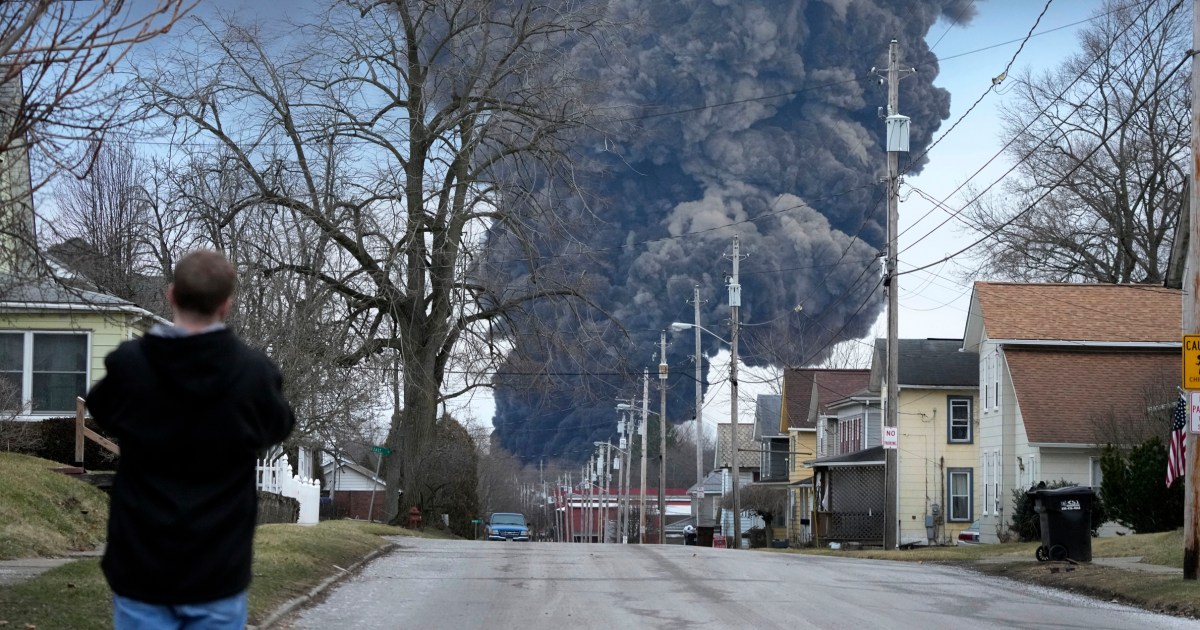Investigation Into Lingering Toxic Chemicals In Buildings Following Ohio Train Derailment

Table of Contents
Assessing the Spread of Toxic Chemicals
The Ohio train derailment released a cocktail of hazardous substances into the surrounding environment. The volatile nature of chemicals like vinyl chloride and butyl acrylate, coupled with unpredictable weather patterns, significantly impacted their spread. Understanding how these lingering toxic chemicals infiltrated buildings is critical to addressing the long-term health and environmental risks.
Several factors influenced the dispersion of these chemicals:
- Wind patterns: Prevailing winds carried plumes of released chemicals, potentially depositing them on building surfaces and infiltrating through ventilation systems.
- Water runoff: Rainfall and snowmelt could have washed chemicals into storm drains and water bodies, potentially contaminating groundwater and subsequently affecting building water supplies.
- Soil composition: The type of soil in the affected area influences the absorption and retention of chemicals, affecting their long-term persistence and potential for leaching into building foundations.
How did these chemicals enter buildings?
- Air infiltration: Volatile organic compounds (VOCs) like vinyl chloride can easily penetrate building materials and enter through cracks, windows, and ventilation systems.
- Contaminated water supplies: If groundwater or surface water sources were contaminated, buildings relying on these sources could have experienced contamination through their plumbing systems.
Detecting these lingering toxic chemicals requires sophisticated testing methods, including:
- Air sampling: Analyzing air quality within buildings to identify the presence and concentration of specific VOCs.
- Water testing: Analyzing water samples from building plumbing systems to detect dissolved chemicals.
- Soil sampling: Assessing soil contamination around buildings to determine the extent of subsurface contamination.
It's crucial to acknowledge the limitations of current testing methods. Some chemicals may be difficult to detect at low concentrations, and the long-term effects of exposure to mixtures of chemicals remain largely unknown.
Health Risks Associated with Lingering Chemicals
Exposure to the chemicals released during the Ohio train derailment poses significant health risks, both in the short-term and long-term. The severity of these risks depends on factors such as the concentration of the chemicals, the duration of exposure, and the individual's health status.
Potential health effects include:
- Respiratory problems: Vinyl chloride, for example, can cause irritation of the respiratory tract, leading to coughing, shortness of breath, and potentially more severe conditions.
- Cancer risks: Long-term exposure to several of the released chemicals is linked to an increased risk of various cancers.
- Neurological effects: Some chemicals may cause neurological symptoms, including headaches, dizziness, and cognitive impairment.
Vulnerable populations, including children, the elderly, and individuals with pre-existing respiratory or cardiovascular conditions, are at a higher risk of experiencing severe health consequences.
Specific health concerns related to each chemical:
- Vinyl chloride: Liver cancer, brain cancer, and other cancers.
- Butyl acrylate: Skin and eye irritation, respiratory problems.
Symptoms of exposure can vary but may include:
- Headaches
- Nausea
- Dizziness
- Respiratory irritation
Resources for those experiencing health problems should be readily available, including local health departments and healthcare providers specializing in toxicology.
Remediation and Building Safety Measures
Cleaning up and remediating buildings contaminated with lingering toxic chemicals is a complex and challenging process. The choice of remediation technique depends on several factors, including the type and concentration of contaminants, the building's construction, and the cost involved.
Remediation techniques may include:
- Air purification: Using specialized equipment to filter and remove VOCs from the air.
- Decontamination: Cleaning and treating surfaces to remove chemical residues.
- Demolition: In severe cases, demolition of severely contaminated buildings may be necessary.
Challenges and considerations:
- Cost factors: Remediation can be very expensive, potentially placing a significant burden on homeowners, businesses, and the government.
- Regulatory frameworks: Cleanup efforts must adhere to strict environmental regulations set by agencies like the EPA.
- Building safety: Ensuring the safety of workers and residents during and after remediation is paramount, requiring the implementation of appropriate safety protocols and monitoring.
Government Response and Public Accountability
The government's response to the Ohio train derailment and the subsequent spread of lingering toxic chemicals has been met with both praise and criticism. The EPA and other regulatory agencies play a crucial role in overseeing cleanup efforts and ensuring public safety.
However, criticisms have included:
- Delays in responding to the initial incident.
- Concerns about the adequacy of cleanup measures.
- Lack of transparency in communicating information to the affected communities.
Legal ramifications for Norfolk Southern, the company responsible for the derailment, are significant and ongoing. The extent of their liability for cleanup costs and compensation for health damages remains to be determined. Transparency regarding chemical levels in affected areas is essential to public trust and informed decision-making.
Conclusion: Investigation into Lingering Toxic Chemicals in Buildings Following Ohio Train Derailment
The investigation into lingering toxic chemicals in buildings following the Ohio train derailment highlights the significant risks associated with environmental contamination from industrial accidents. The long-term health consequences of exposure to these chemicals remain a serious concern, demanding thorough investigation and comprehensive remediation efforts. Robust safety measures are essential to protect public health, and ongoing monitoring is crucial to ensure the effectiveness of cleanup efforts. Transparency and open communication from government agencies and responsible parties are vital to rebuilding trust within affected communities.
We urge you to stay informed about the ongoing investigation into lingering toxic chemicals and to contact your local health department or the EPA if you suspect contamination in your building. Share this article to raise awareness and promote further research on the long-term health and environmental consequences of this devastating event. The health and safety of our communities depend on our collective vigilance in addressing the lingering effects of this disaster.

Featured Posts
-
 Cassidy Hutchinson To Publish Memoir Detailing January 6th Hearing Testimony
May 31, 2025
Cassidy Hutchinson To Publish Memoir Detailing January 6th Hearing Testimony
May 31, 2025 -
 Etude Comparative De L Ingenierie Castor Sur Deux Sites De La Drome
May 31, 2025
Etude Comparative De L Ingenierie Castor Sur Deux Sites De La Drome
May 31, 2025 -
 Solve The Nyt Mini Crossword Saturday April 19th Hints And Answers
May 31, 2025
Solve The Nyt Mini Crossword Saturday April 19th Hints And Answers
May 31, 2025 -
 Matthew Sexton Pleads Guilty To Animal Pornography Charges
May 31, 2025
Matthew Sexton Pleads Guilty To Animal Pornography Charges
May 31, 2025 -
 Trump Welcomes Musk To The Oval Office What Does It Mean
May 31, 2025
Trump Welcomes Musk To The Oval Office What Does It Mean
May 31, 2025
